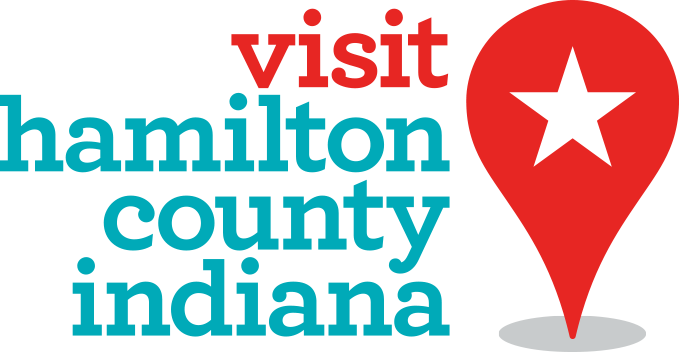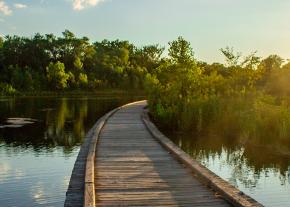According to the American Audubon Society, there are more than 47 million birders in the United States. The observation of birds as a recreational activity has grown in popularity, and there are plenty of places to go birding in Indiana, including parks here in Hamilton County.
“How do I start birding? What do I need? How do I identify birds? Where are the best places to bird near me?” To answer these questions and more, we talked to Amanda Smith, Superintendent of Natural Resources & Education and resident birder for the Hamilton County Parks & Recreation Department.
What is Birding?
You may hear the terms “birding” and “birdwatching” used interchangeably, but Smith said there’s a difference.
Birdwatching is a more casual, passive observation of birds in your environment. Think: admiring the birds that come to the bird feeder in your yard.
Birding, on the other hand, is a verb and refers to actively looking for birds. Think: you grab your binoculars, leave your house and venture out to specifically find birds at a local park or on a trail. Birding can be a competitive sport as birders compare how many species are on their “life list” or “year list,” referring to the number of unique species they’ve seen in their life or a single year, respectively.
Smith said the rise of social media has helped connect avid birders to meet up for bird hikes, share photos of birds, ask questions, get advice, and brag about the birds they’ve seen. It’s also a great way to socialize and meet new people with similar interests.
Birding Tips for Beginners
If you’re new to birding, Smith recommends going on a guided hike. An advanced birder can help you spot birds in the wild.
Smith said binoculars are helpful, but not necessary. Go for small and compact binoculars that are easy to carry. A bird guide can help adjust the settings on a pair of binoculars. Pro tip: if you pull binoculars away from your face and your eyes hurt, those are not the binoculars for you, she said.
In addition to binoculars, Smith recommends a bird guide or field guide specific to the region, or the Merlin app to search for birds based on their physical appearance or an uploaded photo. Focus on identifying a bird based on their size and color; it’s difficult to identify bird songs and calls unless you’re an expert.
Best Places for Birding
You can see common birds like cardinals and mourning doves in backyard bird feeders, but only 20 to 25 percent of birds found in Indiana actually come and visit bird feeders. The rest are migratory species that don’t live in Indiana year-round – or they prefer to eat insects. That’s why birds are more plentiful in parks - it’s more heavily wooded than the average neighborhood, and parks don’t use pesticides or harmful chemicals.
In addition to Smith’s park recommendations, this section features information from Carmel Clay Parks and Recreation Natural Resources Coordinator, Joanna Scott.
Central Park
Carmel
Scott described this as an ideal spot to visit during spring and fall when migratory birds look for pockets of woodlands like Central Park East Woods and Woodland Gardens to gather food and rest while on their flyover journey. Birders might see varieties of warblers, like the Yellow, Prothonotary, Blue-Winged and Yellow-throated, in addition to species like Flycatchers, Grosbeaks, Orioles, Thrushes and American Redstarts. “With an array of native plant sources to eat from and habitat cover from the overstory trees, Central Park makes a great stop for our migrating birds,” Scott said.
Cool Creek Park and Nature Center
Westfield
Smith leads beginning bird hikes here on alternating Sundays, and other birding groups informally gather here.
Flowing Well Park
Carmel
This park is under construction through Spring 2021, but Smith highly recommends Flowing Well as a location to watch spring migration.
Founders Park
Carmel
While this is not necessarily a birdwatching “hot spot,” Scott said visitors can often spot birds of prey at Founders Park, such as Red-tailed Hawks, Broad Winged Hawks, Red-shouldered Hawks, Coopers Hawks and occasionally a Bald Eagle. “With this park’s proximity to the White River, these larger birds of prey will pick up on air currents to soar over the park,” she said.
Hague Road Nature Haven
Noblesville
Located between State Roads 32 and 38 on Hague Road is this undisturbed nature haven, described by visitors as a “hidden gem” and “excellent place for birding.”
MacGregor Park
Westfield
The woods and prairies at MacGregor Park are described as serene and quiet, despite its location at the junction of US31 and Highway 38. Find the giant manmade birds’ nest for a fun photo op.
Ritchey Woods Nature Preserve
Fishers
Ritchey Woods is one of only two state-designated nature preserves in the county on approximately 127 acres. Visitors are bound to see birds while walking on the nine trails totaling 2.25 miles, including a swamp trail.
The Rookery Preserve
Atlanta
The preserve is open year-round from dawn until dusk, but visiting is recommended March-May when vegetation is low and birders can see the nearly 100 Great Blue Herons that nest in the area.
Strawtown Koteewi Park
Noblesville
Pronounced “Koh-TAY-wee,” this is Hamilton County’s largest park, encompassing more than 800 acres. Strawtown Koteewi Park includes eight miles of trails and stretches along three miles of White River, making it an excellent spot to see wildlife.
West Park
Carmel
Birders can find a unique species of shorebird at West Park: the American Woodcock, a small but plump camouflaged bird with a long beak. Scott detailed the males’ impressive mating display to lure females. “The male will sit on the ground making a buzzing noise then will fly high up in the sky, circle and dive back down to the ground. Right around sunset on a spring night is the time to catch a glimpse – it’s a sight to see in the spring!” she said.
White River Corridor
Carmel
Scott groups together the White River Greenway, Hazel Landing Park and River Heritage Park as Carmel’s “White River Corridor,” where birders can spot waterfowl like the Belted Kingfisher and varieties of ducks like Mallards, Wood Ducks, Mergansers and Teal. “All these parcels have areas of forest buffer along the White River, making excellent habitat with cover and food sources for a variety of birds,” Scott said. “I always listen for Belted Kingfishers along White River; they have a rattly noise they make especially as they plunge down from their perch to the water.”
When to Go Birding
Spring migration for songbirds is typically the last week of April through the third week of May, and fall migration is in September.
Smith said birds are active throughout the day, but early morning is ideal since birds need to eat when insects are active. Dusk is also a popular time for bird sightings.
Winter is the perfect time for beginners to try birding since there are no leaves on the trees and it’s easier to spot birds. Smith said most birds you’ll see in the winter months are residents birds of Indiana - think cardinals, woodpeckers and goldfinches. Spend time learning the common species now, and by the time the migration season arrives in spring, the novice birder will be able to differentiate the resident birds from the migratory birds.
Resources
Smith hosts a beginning bird hike at Cool Creek Park and Nature Center every other Sunday. A group of more advanced birders meets for a hike every Wednesday at 9 a.m. at Cool Creek, except for the first Wednesday of the month, when they meet at Strawtown Koteewi Park. Smith says guests can park in the north parking lot and gather there for the hike. Birdwatchers of all ages also gather on Saturdays, informally.
Smith recommends Ebird, a website where birders can record their findings and the data goes to Cornell University to help its research program.
Bird enthusiasts can learn more from the Indiana Audubon Society with the Indiana Birding Trail and Indiana Bird Checklist.







 Back to Previous
Back to Previous
